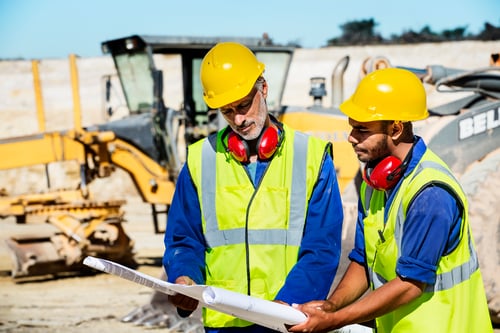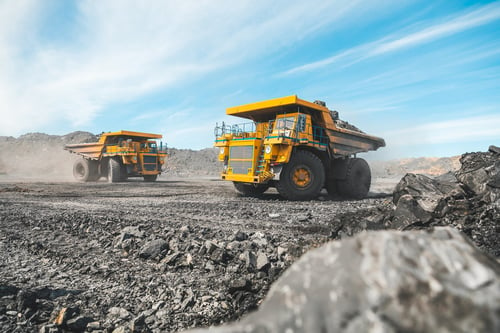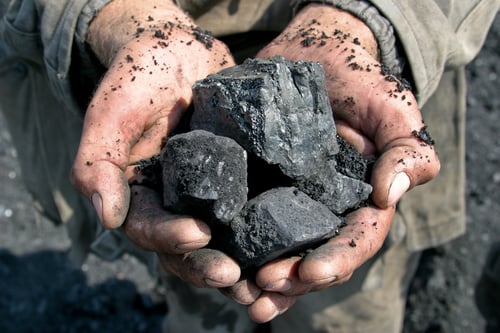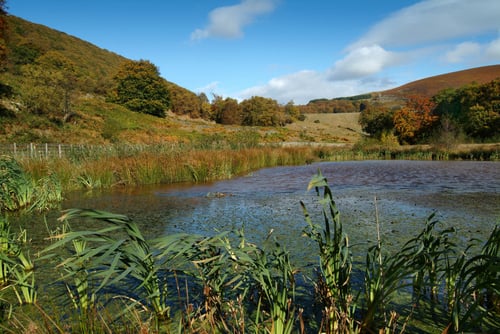Blog Post
Mining 101: Intro to Mining
Aug. 5, 2020

For the average Joe, the word “mining” might spark an image of old-timey workers, covered in soot and dirt, picks slung over their shoulders and helmets on their heads. Others might recall the legendary gold-rush stories of our school days, picturing the determined men and women who sought a bonanza in the streams of California.
Neither idea is particularly accurate when it comes to today’s miners.
![Hard-coal-mine-underground-corridor-with-steel-support-system-electrical-equipment]() Photo courtesy of iStock/ewg3DHard coal mine underground corridor with steel support system and electrical equipment.
Photo courtesy of iStock/ewg3DHard coal mine underground corridor with steel support system and electrical equipment.
![]()
 Photo courtesy of iStock/ewg3DHard coal mine underground corridor with steel support system and electrical equipment.
Photo courtesy of iStock/ewg3DHard coal mine underground corridor with steel support system and electrical equipment.
A Brief History
Early civilizations created mines by digging a shaft, either by hand or with primitive tools, and hauling the materials out. It was a slow and tedious process. Explosive black powder arrived on the scene in the Middle Ages, A.D. 476 to approximately A.D. 1450, shaking things up and speeding the mining process dramatically. Dynamite—invented in the 1800s—ushered the industry into an era where the ground could be opened with a literal boom.
Each advancement in technology made mining a little bit easier. Candles were replaced by whale oil lamps, which were replaced by lightbulbs, making it easier for miners to see their workspace. Pneumatic drills replaced hand tools, providing greater accuracy and power. Today’s mining is accomplished with heavy machinery, explosives and drills, trucks and bulldozers, and miners who are valued for their brains over their brawn.
Mining 101
Boiling it down to basics, mining is the process of extracting minerals or other valuable materials from the earth. Chalk, flint, and ochre were some of the first items to be mined by early civilizations, with the oldest underground mine dating back more than 40,000 years in the distant mountains of Swaziland in Africa.
Silver, gold, marble, salt, diamonds and other precious gems, metal, oil, coal, and natural gases are all examples of materials obtained through mining. From the fuel that powers our vehicles to the countertops in our kitchens, the products from mining remain an enormous part of daily life.
Take iron, for example. By adding up the number of nails, saws, pipes, grills, stoves, rails, cars, electronics, tools, and more used in modern life, the Minerals Education Coalition estimates that every American will rely on 27,416 pounds of iron throughout their lifetime, making iron ore one of the most integral parts of the world’s economy.
Our iron use only scratches the surface of a much deeper dependency on the mining industry. It’s estimated that every American baby born in 2019 will use 3.19 million pounds of mined materials over the course of their lifetime: more than 30,000 pounds of salt, 75,000 gallons of petroleum, 53,000 pounds of cement, and the list goes on.
Between minerals, metals, and fuels, we’re dependent on mining.
Our reliance on mined items has even prompted a popular saying in the industry: “if it can’t be grown, it must be mined.” Originating in Missouri, this saying was created by the mining industry to show the large impact that farming and mining have in that state.
Types of Mining
Underground and surface mining are the most common types of mining, but they are only two of the four main types.
![Coal-geologist]() Photo courtesy of iStock/buranatrakul Coal geologist at a mine.
Photo courtesy of iStock/buranatrakul Coal geologist at a mine.
![Construction-workers-examining-blueprint-at-quarry]() Photo courtesy of iStock/Morsa Images Construction workers examining blueprint at quarry.
Photo courtesy of iStock/Morsa Images Construction workers examining blueprint at quarry.
![Large-quarry-loading-rock-in-dump-truck]() Photo courtesy of iStock/qwerty01 Large quarry loading rock in a dump truck.
Photo courtesy of iStock/qwerty01 Large quarry loading rock in a dump truck.
![Miner-holding-coal-in-hands]() Photo courtesy of iStock/svet110 A miner holding coal in hands.
Photo courtesy of iStock/svet110 A miner holding coal in hands.
![Cwmtillery-reservoir]() Photo courtesy of iStock/Christopher Jones The Cwmtillery Reservoir.
A Look at the Numbers: Mining in the U.S.
In 2019, the United States produced $86.3 billion of non-fuel minerals, mostly industrial materials like stone, sand, and gravel. According to the United States Geological Survey, crushed stone, cement, construction sand and gravel, gold, copper, industrial sand and gravel, iron ore, lime, salt, zinc, soda ash, phosphate rock, and molybdenum concentrates were 13 minerals commodities that were each valued at more than $1 billion that year.
13 proved a lucky number for America in 2019—there were also 13 states that produced more than $2 billion in non-fuel minerals. Nevada, Arizona, Texas, Minnesota, and California led the pack.
As for coal, the U.S. produces upward of 750 million short tons every year through a combination of surface and underground mines. Wyoming produces the most of any state (by far), at more than 300 million short tons or 40 percent of America’s total production. West Virginia, Pennsylvania, Illinois, and Kentucky fill out the rest of the top five coal mining states.
With so much coal at our fingertips, America is able to export a fair amount. In 2018, the U.S. exported more than 100 million short tons of coal—importing less than six. (Strange as it may seem, it is cheaper for some coastal towns to import coal rather than transport it from America’s coal regions.)
Trade wars, elections, and changes in environmental regulations make it difficult to predict exactly how the numbers will shake out over the coming years, but the future of mining looks strong. Ever-evolving technology (in line link: mining blog 3) and innovative breakthroughs make the industry safer, more cost-effective, and more environmentally friendly, improving life for both miners and consumers. For instance, the mining industry has been using virtual reality to train miners how to use explosives without putting themselves or others at risk.
If you’re seeking specific solutions to a mining challenge, we’d be delighted to offer our trusted solutions and help your company thrive in the months and years to come. Contact us through our website to get started.
Sources:
Photo courtesy of iStock/Christopher Jones The Cwmtillery Reservoir.
A Look at the Numbers: Mining in the U.S.
In 2019, the United States produced $86.3 billion of non-fuel minerals, mostly industrial materials like stone, sand, and gravel. According to the United States Geological Survey, crushed stone, cement, construction sand and gravel, gold, copper, industrial sand and gravel, iron ore, lime, salt, zinc, soda ash, phosphate rock, and molybdenum concentrates were 13 minerals commodities that were each valued at more than $1 billion that year.
13 proved a lucky number for America in 2019—there were also 13 states that produced more than $2 billion in non-fuel minerals. Nevada, Arizona, Texas, Minnesota, and California led the pack.
As for coal, the U.S. produces upward of 750 million short tons every year through a combination of surface and underground mines. Wyoming produces the most of any state (by far), at more than 300 million short tons or 40 percent of America’s total production. West Virginia, Pennsylvania, Illinois, and Kentucky fill out the rest of the top five coal mining states.
With so much coal at our fingertips, America is able to export a fair amount. In 2018, the U.S. exported more than 100 million short tons of coal—importing less than six. (Strange as it may seem, it is cheaper for some coastal towns to import coal rather than transport it from America’s coal regions.)
Trade wars, elections, and changes in environmental regulations make it difficult to predict exactly how the numbers will shake out over the coming years, but the future of mining looks strong. Ever-evolving technology (in line link: mining blog 3) and innovative breakthroughs make the industry safer, more cost-effective, and more environmentally friendly, improving life for both miners and consumers. For instance, the mining industry has been using virtual reality to train miners how to use explosives without putting themselves or others at risk.
If you’re seeking specific solutions to a mining challenge, we’d be delighted to offer our trusted solutions and help your company thrive in the months and years to come. Contact us through our website to get started.
Sources:
-
Underground
-
Surface
-
Placer
-
In-Situ
-
Exploration
 Photo courtesy of iStock/buranatrakul Coal geologist at a mine.
Photo courtesy of iStock/buranatrakul Coal geologist at a mine.
-
Planning
 Photo courtesy of iStock/Morsa Images Construction workers examining blueprint at quarry.
Photo courtesy of iStock/Morsa Images Construction workers examining blueprint at quarry.
-
Development/Construction
 Photo courtesy of iStock/qwerty01 Large quarry loading rock in a dump truck.
Photo courtesy of iStock/qwerty01 Large quarry loading rock in a dump truck.
-
Production
 Photo courtesy of iStock/svet110 A miner holding coal in hands.
Photo courtesy of iStock/svet110 A miner holding coal in hands.
-
Closure/Reclamation
 Photo courtesy of iStock/Christopher Jones The Cwmtillery Reservoir.
A Look at the Numbers: Mining in the U.S.
In 2019, the United States produced $86.3 billion of non-fuel minerals, mostly industrial materials like stone, sand, and gravel. According to the United States Geological Survey, crushed stone, cement, construction sand and gravel, gold, copper, industrial sand and gravel, iron ore, lime, salt, zinc, soda ash, phosphate rock, and molybdenum concentrates were 13 minerals commodities that were each valued at more than $1 billion that year.
13 proved a lucky number for America in 2019—there were also 13 states that produced more than $2 billion in non-fuel minerals. Nevada, Arizona, Texas, Minnesota, and California led the pack.
As for coal, the U.S. produces upward of 750 million short tons every year through a combination of surface and underground mines. Wyoming produces the most of any state (by far), at more than 300 million short tons or 40 percent of America’s total production. West Virginia, Pennsylvania, Illinois, and Kentucky fill out the rest of the top five coal mining states.
With so much coal at our fingertips, America is able to export a fair amount. In 2018, the U.S. exported more than 100 million short tons of coal—importing less than six. (Strange as it may seem, it is cheaper for some coastal towns to import coal rather than transport it from America’s coal regions.)
Trade wars, elections, and changes in environmental regulations make it difficult to predict exactly how the numbers will shake out over the coming years, but the future of mining looks strong. Ever-evolving technology (in line link: mining blog 3) and innovative breakthroughs make the industry safer, more cost-effective, and more environmentally friendly, improving life for both miners and consumers. For instance, the mining industry has been using virtual reality to train miners how to use explosives without putting themselves or others at risk.
If you’re seeking specific solutions to a mining challenge, we’d be delighted to offer our trusted solutions and help your company thrive in the months and years to come. Contact us through our website to get started.
Sources:
Photo courtesy of iStock/Christopher Jones The Cwmtillery Reservoir.
A Look at the Numbers: Mining in the U.S.
In 2019, the United States produced $86.3 billion of non-fuel minerals, mostly industrial materials like stone, sand, and gravel. According to the United States Geological Survey, crushed stone, cement, construction sand and gravel, gold, copper, industrial sand and gravel, iron ore, lime, salt, zinc, soda ash, phosphate rock, and molybdenum concentrates were 13 minerals commodities that were each valued at more than $1 billion that year.
13 proved a lucky number for America in 2019—there were also 13 states that produced more than $2 billion in non-fuel minerals. Nevada, Arizona, Texas, Minnesota, and California led the pack.
As for coal, the U.S. produces upward of 750 million short tons every year through a combination of surface and underground mines. Wyoming produces the most of any state (by far), at more than 300 million short tons or 40 percent of America’s total production. West Virginia, Pennsylvania, Illinois, and Kentucky fill out the rest of the top five coal mining states.
With so much coal at our fingertips, America is able to export a fair amount. In 2018, the U.S. exported more than 100 million short tons of coal—importing less than six. (Strange as it may seem, it is cheaper for some coastal towns to import coal rather than transport it from America’s coal regions.)
Trade wars, elections, and changes in environmental regulations make it difficult to predict exactly how the numbers will shake out over the coming years, but the future of mining looks strong. Ever-evolving technology (in line link: mining blog 3) and innovative breakthroughs make the industry safer, more cost-effective, and more environmentally friendly, improving life for both miners and consumers. For instance, the mining industry has been using virtual reality to train miners how to use explosives without putting themselves or others at risk.
If you’re seeking specific solutions to a mining challenge, we’d be delighted to offer our trusted solutions and help your company thrive in the months and years to come. Contact us through our website to get started.
Sources:
- https://www.britannica.com/technology/mining
- https://www.hibbingmn.com/mine/mining-products-for-our-everyday-life/article_0956547c-a0a9-11e3-8e62-001a4bcf887a.html
- https://mineralseducationcoalition.org/mining-minerals-information/all-about-mining/
- https://mineralseducationcoalition.org/wp-content/uploads/2019-Mineral-Baby.pdf
- https://www.generalkinematics.com/blog/a-brief-history-of-mining-and-the-advancement-of-mining-technology/
- https://www.usgs.gov/news/us-mine-production-increasing-estimated-value-863-billion-minerals
- https://www.eia.gov/energyexplained/coal/where-our-coal-comes-from.php
- https://www.eia.gov/tools/faqs/faq.php?id=69&t=2
- https://www.eia.gov/energyexplained/coal/imports-and-exports.php
- https://thebossmagazine.com/mining-process-stages/
- https://www.miningglobal.com/operations/gifs-5-stages-mining-life-cycle
- https://www.bdo.global/getmedia/34a01421-6dfc-4e0b-a162-ee6c4e8ba7b8/BDO_2023_Mining-Predictions.pdf.aspx
- https://resourceworld.com/how-to-build-a-mine/
- https://www.miningglobal.com/operations/gifs-5-stages-mining-life-cycle
- https://www.msha.gov/compliance-enforcement/mine-inspections
- https://www.heavyequipmentschool.com/heavy-equipment-mining-industry/
- https://www.americangeosciences.org/critical-issues/faq/can-we-mitigate-environmental-impacts-mining#id3
 US | en
US | en